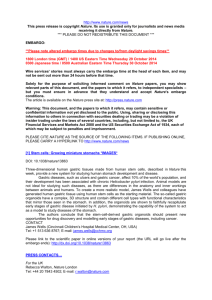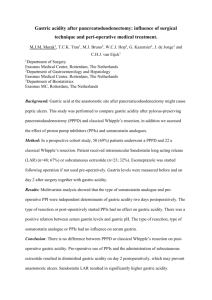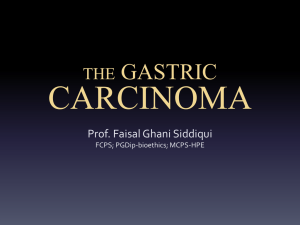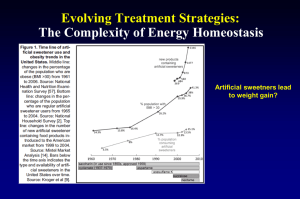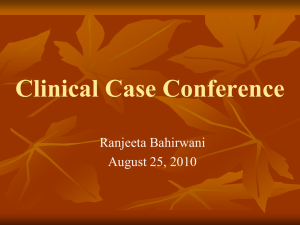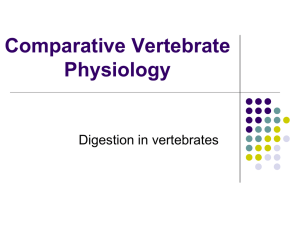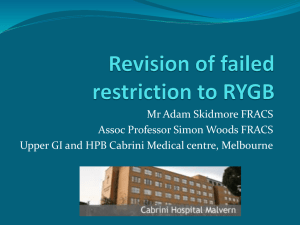Gastric Bezoar 9/19/11 Morning Report
advertisement
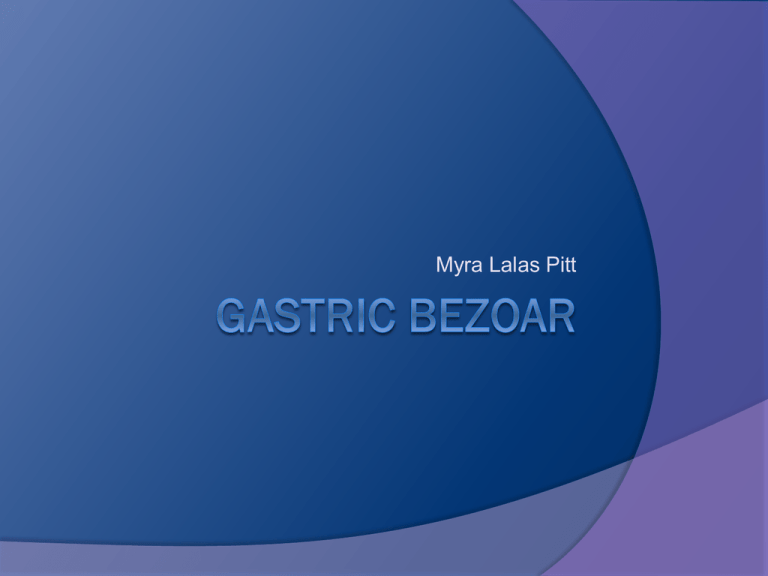
Myra Lalas Pitt 1. NO DIRECT CT EVIDENCE OF APPENDICITIS. 2. GASTRIC BEZOAR VERSUS FOODSTUFF WITHIN THE STOMACH. 3. RIGHTSIDED ADNEXAL CYST WITH FREE FLUID IN CUL DE SAC CONSISTENT WITH CYST RUPTURE. 4. TRACE AMOUNT OF PERIPORTAL EDEMA. ULTRASOUND MAY BE OBTAINED IF CLINICALLY INDICATED. 5. FECAL MATERIAL THROUGHOUT THE ENTIRE COLON CONSISTENT WITH CONSTIPATION. Definition Result from the accumulation of foreign ingested material in the form of masses or concretions Rare and occurs in <1% of the population Grow by the continuing intake of food rich in cellulose and other indigestible materials such as hair, cotton, and tissue paper, matted together by protein, mucus, and pectin. Pathophysiology Properties of the ingested material and some degree of gastric dysfunction may lead to its formation Risk Factors: Previous gastric surgery Delayed gastric emptying Signs and Symptoms Phytobezoars: men in their 40s-50s Trichobezoars: women in their 20s Symptoms usually develop insidiously: Abominal pain Nausea/ vomiting Early satiety Anorexia Weight loss GI bleeding Diagnosis AXR: CT Scan Gastric trichobezoar Treatment Depend on their composition, location and size. Dissolution therapy (cellulase, acetylcystein, papain and Coca Cola) Endoscopic fragmentation and/or aspiration Surgery Endoscopic removal of the yellowgreenish-colored bezoar and normal gastric mucosa. Gastric bezoar dissolution with oral CocaCola® intake Sara Regaño, Marisol Trugeda, Gonzalo Gutierrez, Susana Menéndez and Gonzalo De las Heras, 05 May 2009 Lavage with Coca-Cola® as a safe and effective treatment for gastric bezoars was first described in 2002 Case of 64 yo F with hypogastric pain & gastric fullness for 3 years; h/o DM type 2 and hyperthyroidism Meds: Omeprazol®, plus oral antidiabetic agents, and Thirodril The patient was asked to drink 3 cans of Coca-Cola® per day with every meal (33 cl. 3 times a day) for a month. The mechanism of Coca-Cola® dissolution is not fully explained. Phosphoric acid (H3PO4) is responsible for Coke’s pH of 2.6, which is close to the pH of gastric secretions→ acidification of the gastric content may be the way Coca-Cola® acts by disintegrating the bezoar. The release of carbon dioxide (CO2) bubbles into the gastric lumen and the mucolitic action of sodium bicarbonate (NaHCO3) may also contribute to bezoar dissolution. References Azevedo et al. Successful endoscopic resolution of a large gastric bezoar in a child. World J Gastrointest Endosc. 2011 June 16; 3(6): 129–132. Regano et al. Gastric bezoar dissolution with oral Coca-Cola® intake. May 2009 (www.gastrohep.com) www.uptodate.com



